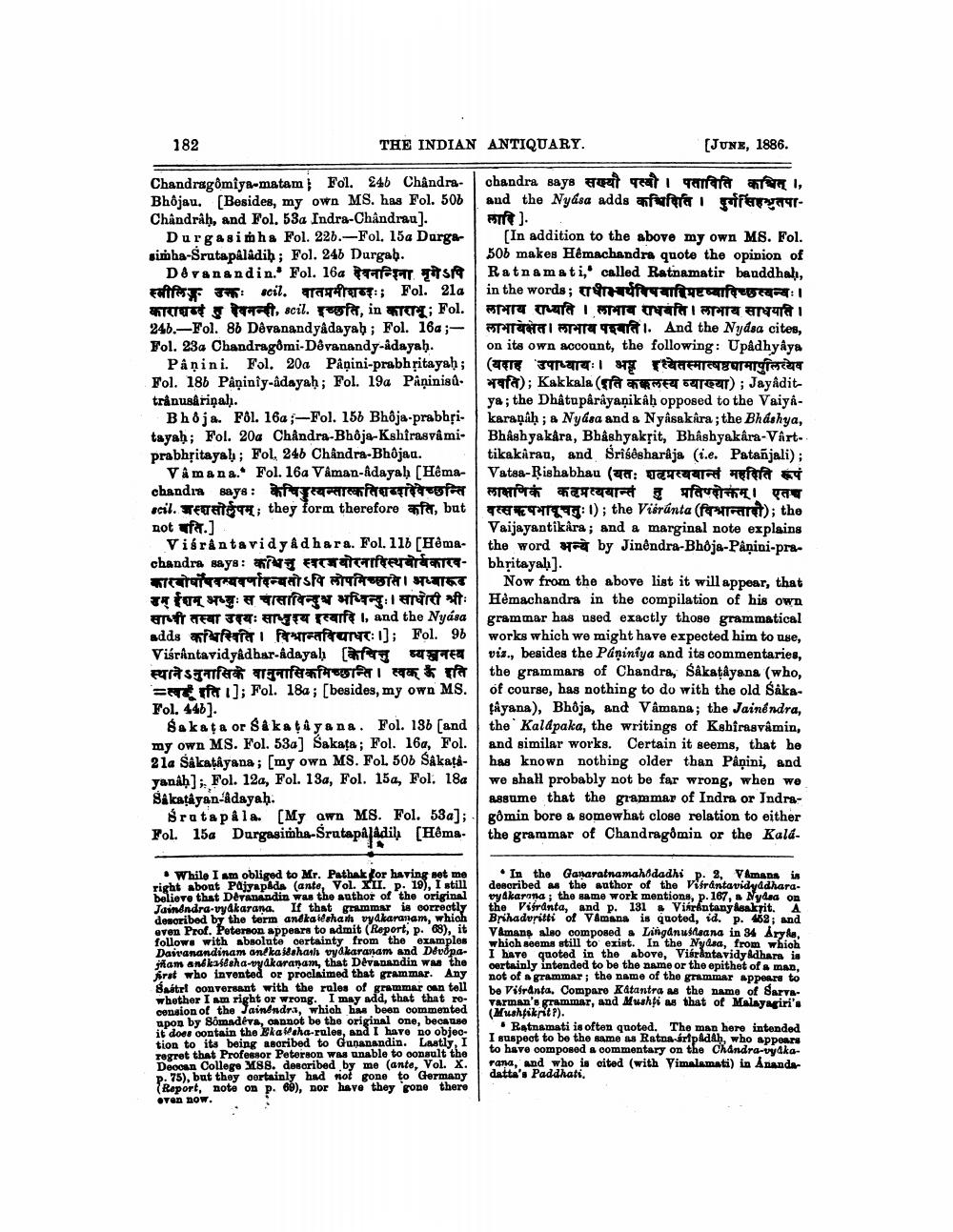________________
182
THE INDIAN ANTIQUARY.
Chandragomiya-matam; Fol. 246 ChândraBhôjau. [Besides, my own MS. has Fol. 50b Chandrah, and Fol. 53a Indra-Chandrau].
Durgasimha Fol. 226.-Fol. 15a Durgasimha-Śrutapâlâdiḥ; Fol. 246 Durgab.
Dovanandin. Fol. 16a
s
स्त्रीलिङ्ग उक्तः scil वातप्रमीशब्दः; Fol. 2la काराशब्दे तु देवनन्दी, scil. इच्छति, in काराभू; Fol. 246.-Fol. 86 Dêvanandyadayah; Fol. 16a;Fol. 23a Chandragômi-Dêvanandy-âdayaḥ.
Vamana. Fol. 16a Vâman-âdayaḥ [Hêmachandra_says: केचित्यन्तात्क तिशब्दादेवेच्छन्ति scil. जस्सोर्लुपम् ; they form therefore कति, but not fa.]
[JUNE, 1886.
chandra says सख्यौ पस्यौ । पताविति कश्चित् ।, aud the Nyäsa adds कच्चिदिति । दुर्गसिंहश्रुतपालाहि ].
Bhoja. Fol. 16a;-Fol. 156 Bhôja-prabhṛitayah; Fol. 20a Chandra-Bhôja-Kshirasvâmiprabhṛitayah; Fol, 246 Chândra-Bhôjau.
Pânini. Fol. 200 Panini-prabhritayah; Fol. 186 Paniniy-âdayaḥ; Fol. 19a Paninisûref); Kakkala (se); Jayâdittrânusârinah. ya; the Dhâtupârâyanikâh opposed to the Vaiyakaraṇaḥ; a Nyása and a Nyâsakâra; the Bhashya, Bhashyakara, Bhashyakṛit, Bhashyakâra-Vârttikakarau, and Sriśêsharaja (i.e. Patanjali); Vatsa- Rishabhau (यतः शतृप्रत्ययान्तं महदिति रूपं लाक्षणिकं कप्रत्ययान्तं तु प्रतिपदोक्तंम् । एतच वत्सऋषभावूचतुः 1) ; the Visránta (विश्रान्तादी); the Vaijayantikara; and a marginal note explains the word by Jinêndra-Bhôja-Panini-prabhritayal].
Now from the above list it will appear, that Hemachandra in the compilation of his own grammar has used exactly those grammatical works which we might have expected him to use, viz., besides the Pániniya and its commentaries, the grammars of Chandra, Śâkațâyana (who, of course, has nothing to do with the old Sakatâyana), Bhôja, and Vâmana; the Jainendra, the Kalapaka, the writings of Kshirasvamin, and similar works. Certain it seems, that he has known nothing older than Panini, and we shall probably not be far wrong, when we assume that the grammar of Indra or Indragômin bore a somewhat close relation to either the grammar of Chandragômin or the Kalá
Visrantavidyadhara. Fol. 116 [Hêmachandra says: कश्चित्तु स्वरजयोरनाहिस्थबोर्बकारव - कारबोधयवस्यवर्णादन्यतोऽपि लोपमिच्छाते । अध्यारूड चासाविन्दुध मध्विन्तु। श्री
तस्या उदयः साध्नुश्य इत्यादि ।, and the Nyasa adds कश्विस्थिति। विश्रान्तविद्याधरः ।]; Fol. 96 Virkntavidyadhar-idayah fr स्थानेऽनुनासिके वानुनासिकमिच्छन्ति । स्वक् के इति fr]; Fol. 18a; [besides, my own MS. Fol. 446].
Sakata or Sakatayana. Fol. 136 [and my own MS. Fol. 53a] Sakata; Fol. 16a, Fol. 21a Sakatayana; [my own MS. Fol. 506 Sakata yanah]; Fol. 12a, Fol. 13a, Fol. 15a, Fol. 18a Sakatayan-âdayah.
Sratapala. [My own MS. Fol. 53a]; Fol. 15a Durgasimha-Śrutapâlâdil [Hêma
While I am obliged to Mr. Pathak for having set me right about Pajyapada (ante, Vol. XII. p. 19), I still believe that Devanandin was the author of the original Jainendra-vyakarana. If that grammar is correctly described by the term anékailsham vyakaranam, which even Prof. Peterson appears to admit (Report, p. 68), it follows with absolute certainty from the examples Daivanandinam anekaidehash vyakaranam and Devopajam anékas@sha-vyakaranam, that Devanandin was the rat who invented or proclaimed that grammar. Any Sastri conversant with the rules of grammar can tell whether I am right or wrong. I may add, that that rocension of the Jainendra, which has been commented upon by Somadeva, cannot be the original one, because it does contain the Ekasha-rules, and I have no objec tion to its being ascribed to Gunanandin. Lastly, I regret that Professor Peterson was unable to consult the Deccan College MSS. described by me (ante, Vol. X. p. 75), but they certainly had not gone to Germany Report, note on p. 69), nor have they gone there
even now.
[In addition to the above my own MS. Fol. 506 makes Hemachandra quote the opinion of Ratna mati, called Ratnamatir bauddhaḥ, in the words ; राधीश्वर्थविषयाद्विप्रष्टष्यादिच्छत्वन्यः । लाभाय राध्यति । लाभाव राधयति । लाभाय साधयति । लाभायेक्षेत । लाभाव पश्यति ।. And the Nydsa cites, on its own account, the following: Upadhyaya ( यदाह उपाध्यायः । अट्ट इत्येतस्मात्षष्ठधामापुलित्येव
A
In the Ganaratnamahodadhi p. 2, Vamans is described as the author of the Virántavidyadharavyakarana; the same work mentions, p. 167, a Nydea on the Viranta, and p. 131 a Virántanyasakrit. Brihadvritti of Vamana is quoted, id. p. 452; and Vamans also composed a Lingánussana in 34 Arys, which seems still to exist. In the Nyasa, from which I have quoted in the above, Viárantavidyadhara is certainly intended to be the name or the epithet of a man, not of a grammar; the name of the grammar appears to be Viiranta. Compare Katantra as the name of SarvaVarman's grammar, and Mushți as that of Malayagiri's (Mushtikrit P).
Ratnamati is often quoted. The man here intended I suspect to be the same as Ratna-áripadah, who appears to have composed a commentary on the Chandra-vyakarana, and who is cited (with Vimalamati) in Anandadatta's Paddhati.




